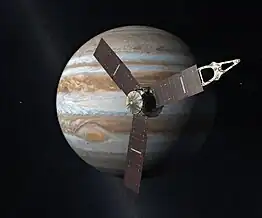| Discovery | |
|---|---|
| Discovery date | July 6, 2016 |
| transit | |
| Orbital characteristics | |
| 0.06229 AU (9,318,000 km) | |
| 4.736529[1] d | |
| Star | HD 93396 |
| Physical characteristics | |
Mean radius | 1.37+0.15 −0.12[1] RJ |
| Mass | 0.195+0.019 −0.018[1] MJ |
Mean density | 0.093+0.028 −0.024 kg m−3 |
| 2.407+0.080 −0.086 m/s² | |
| Temperature | 1712+51 −46[1] |
KELT-11b is an exoplanet orbiting around the yellow subgiant star KELT-11 (HD 93396) about 320 light-years away from Earth. It is an inflated planet, one of the "puffiest planets" known, as a result of its close orbiting distance with its parent star. It has a radius 1.37 times that of Jupiter, but only 19% of its mass. It was discovered in 2016.[1]
The transmission spectrum study in 2020 have revealed the KELT-11b atmosphere containing sub-solar amount of water vapor, but significant amounts of hydrogen cyanide, together with oxides of titanium and aluminum. Also, the nightside flux do indicate a generally cloud-free atmosphere with an effective heat redistribution between dayside and nightside.[2] Later studies have indicated the hydrogen cyanide spectral features are not well distinguished from spectral lines of carbon dioxide and carbon monoxide, although carbon dioxide seems to be present in larger amounts, indicating a high carbon/oxygen ratio of the planet.[3]
References
- 1 2 3 4 5 Pepper, Joshua; Rodriguez, Joseph E.; Collins, Karen A.; Johnson, John Asher; Fulton, Benjamin J.; Howard, Andrew W.; Beatty, Thomas G.; Stassun, Keivan G.; Isaacson, Howard; Colón, Knicole D.; Lund, Michael B.; Kuhn, Rudolf B.; Siverd, Robert J.; Gaudi, B. Scott; Tan, T. G.; Curtis, Ivan; Stockdale, Christopher; Mawet, Dimitri; Bottom, Michael; James, David; Zhou, George; Bayliss, Daniel; Cargile, Phillip; Bieryla, Allyson; Penev, Kaloyan; Latham, David W.; Labadie-Bartz, Jonathan; Kielkopf, John; Eastman, Jason D.; et al. (2017). "KELT-11b: A Highly Inflated Sub-Saturn Exoplanet Transiting the V = 8 Subgiant HD 93396". The Astronomical Journal. 153 (5): 215. arXiv:1607.01755v1. Bibcode:2017AJ....153..215P. doi:10.3847/1538-3881/aa6572. S2CID 30219578.
- ↑ Colón, Knicole D.; Kreidberg, Laura; Line, Michael; Welbanks, Luis; Madhusudhan, Nikku; Beatty, Thomas; Tamburo, Patrick; Stevenson, Kevin B.; Mandell, Avi; Rodriguez, Joseph E.; Barclay, Thomas; Lopez, Eric D.; Stassun, Keivan G.; Angerhausen, Daniel; Fortney, Jonathan J.; James, David J.; Pepper, Joshua; Ahlers, John P.; Plavchan, Peter; Awiphan, Supachai; Kotnik, Cliff; McLeod, Kim K.; Murawski, Gabriel; Chotani, Heena; LeBrun, Danny; Matzko, William; Rea, David; Vidaurri, Monica; Webster, Scott; et al. (2020). "An Unusual Transmission Spectrum for the Sub-Saturn KELT-11b Suggestive of a Subsolar Water Abundance". The Astronomical Journal. 160 (6): 280. arXiv:2005.05153. Bibcode:2020AJ....160..280C. doi:10.3847/1538-3881/abc1e9. S2CID 218581200.
- ↑ Changeat, Q.; Edwards, B.; Al-Refaie, A. F.; Morvan, M.; Tsiaras, A.; Waldmann, I. P.; Tinetti, G. (2020), "KELT-11 b: Abundances of Water and Constraints on Carbon-bearing Molecules from the Hubble Transmission Spectrum", The Astronomical Journal, 160 (6): 260, arXiv:2010.01310, Bibcode:2020AJ....160..260C, doi:10.3847/1538-3881/abbe12, S2CID 222132941


